Hanging Light Fixtures on Sloped Ceilings: A Guide
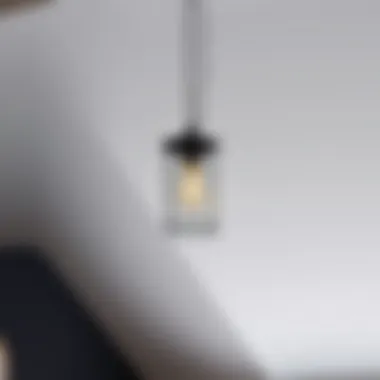
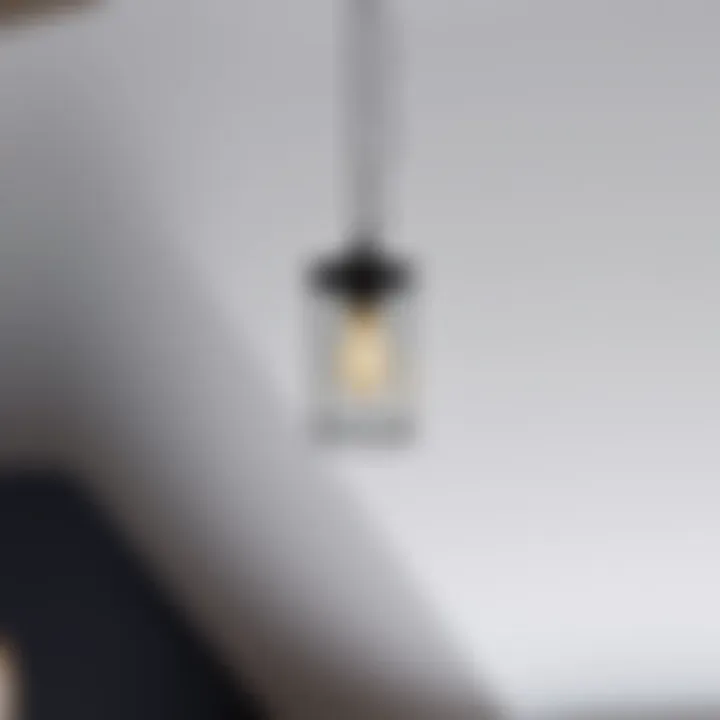
Intro
Navigating the intricacies of lighting in a home, especially with sloped ceilings, can feel like treading water in a storm. Home builders and renovators alike face unique challenges when trying to strike a balance between functional illumination and aesthetic appeal. Hanging light fixtures, though often a favored choice, require a thoughtful approach that considers both the ceiling's angle and the overall design scheme. In this guide, we’ll uncover the nuances of selecting and installing these fixtures, ensuring that even the trickiest of spaces can shine bright with style.
Furniture Design Trends
Current Styles and Themes
The market for furniture and fixtures is constantly evolving, with various trends emerging that shape how homeowners approach their spaces. For sloped ceilings, contemporary designs often emphasize minimalism and functionality, aiming to keep the lines clean while maximizing light. Consider fixtures with geometric shapes or sleek frames that beautifully echo the angles of the ceiling itself.
Rustic elements have also made a notable comeback, allowing for the integration of wood and metal materials that offer a warm, inviting contrast against the cold angles of a sloped ceiling. This blend of styles lends a sense of homeliness while maintaining a designer edge.
Color Palettes and Materials
Color plays a pivotal role in any lighting project, particularly on sloped ceilings where shadows can cast a different light on hues. A soft white or light beige can help create an illusion of height, making the room feel airier. Meanwhile, incorporating materials such as brushed nickel or matte black fixtures can add unexpected depth, challenging dull perceptions of sloped spaces.
When it comes to materials, opting for those that complement the existing decor can work wonders. Think about using glass pendant lights that diffuse light beautifully, or fixtures that exhibit an artisanal flair might give a nod to craftsmanship, enriching the overall ambiance.
"The fixtures you choose can be the statement pieces that draw the eye upward, transforming a sloped ceiling into an architectural feature rather than a limitation."
Practical Lighting Tips
How to Choose the Right Size
Size matters when selecting hanging fixtures for sloped ceilings. A standard rule of thumb is to aim for fixtures that are proportionate to the room's dimensions. Larger spaces may call for oversized pendants which can become focal points, whereas intimate areas benefit from smaller, daintier fixtures that don't overshadow the ambiance.
Consider measuring the height from the floor to the highest point of the ceiling to ensure that your chosen fixture clears any obstructions and stays clear of headroom hazards.
Maintenance and Care for Longevity
The maintenance of hanging light fixtures is another essential aspect to consider. Dust and dirt can accumulate quickly, especially in hard-to-reach areas common with sloped ceilings. Regular cleaning, perhaps using a microfiber cloth or a gentle duster, is advisable to maintain their shine. Additionally, be mindful of the energy-efficient bulbs you choose; opting for LED lights not only enhances longevity but also reduces the frequency of changes.
An easy method to keep fixtures in tip-top shape is to schedule seasonal check-ups. This proactive approach prevents any unnecessary hassles and ensures that even the most complicated angles can continue to dazzle.
Summary
This guide serves as a compass for navigating the delicate intricacies of hanging light fixtures on sloped ceilings. By understanding the trends, sizing, and maintenance, homeowners and interior designers can transform their spaces into beautifully lit gems. For more detailed information on lighting choices, resources such as the Lighting Research Center or articles on Better Homes & Gardens are excellent references. With careful selection and installation, the once daunting sloped ceiling can be tamed into a symphony of light and space.
Understanding Sloped Ceilings
Understanding the nuances of sloped ceilings is crucial for anyone looking to enhance their living space through lighting. Their unique structure not only affects how light behaves in a room, but also contributes significantly to the overall aesthetic of a space. By grasping the particularities of sloped ceilings, homeowners and designers can navigate through challenges—such as installation difficulties and optimal placement—seamlessly.
When one thinks about sloped ceilings, the benefits are manifold. These ceilings can create an illusion of openness and grandeur, allowing light to play in ways that flat ceilings simply can't match. It’s essential to identify the core attributes that make these ceilings distinct, so one can make informed choices when it comes to lighting fixtures. Whether you’re looking to brighten a cozy living room or add ambiance to a dining area, understanding sloped ceilings is the first step in making the most of your space.
Definition and Characteristics
Sloped ceilings, often defined as ceilings that pitch or incline at an angle, come with their own set of characteristics that set them apart from traditional flat ceilings. Generally, the angle of the slope can vary widely, leading to a range of design possibilities. The most notable aspect of these ceilings is their capacity to create an expansive feel within a room, encouraging airiness and luminosity.
One key characteristic to note is how the slope influences light distribution. Light fixtures installed on an incline might cast shadows differently than those on a flat plane. This means that selecting the right fixture and placement can dramatically alter the feel of the space. Additionally, sloped ceilings tend to require more strategic planning regarding fixture height and orientation, as failing to do so could lead to an underwhelming effect.
Types of Sloped Ceilings
Diving deeper, not all sloped ceilings are created equal. They mainly fall into three categories: Cathedral Ceilings, Vaulted Ceilings, and Low-Slope Ceilings. Understanding these types paves the way for better decision-making in terms of lighting.
Cathedral Ceilings
Cathedral ceilings are often eye-catching, featuring two sloping sides that meet at a midpoint, giving a sense of height to the room. This style tends to evoke a feeling of grandeur and spaciousness, making it a popular choice in living areas and dining rooms. The distinctive shape allows for the use of larger light fixtures, such as grand chandeliers, which can serve as focal points.
However, there are challenges too. The steep angle can make installation tricky, especially when considering how to balance light at various heights. Still, the benefits usually trump the drawbacks; the unique aesthetic opens endless possibilities for creative lighting arrangements.
Vaulted Ceilings
Vaulted ceilings are slightly different, as they can have varied slopes and shapes. This variability allows for flexible design but also calls for careful consideration when it comes to lighting. The heights can create spots that require extra care to illuminate effectively, particularly if the slope is steep.
One notable advantage is that these ceilings provide ample space for various lighting fixtures. It’s common to see combinations of recessed lights layered with pendant fixtures dangling from the apex. However, one must always weigh how the light will disperse in remote areas of the room, as fixtures hanging too low could hinder that airy feel you’re aiming for.
Low-Slope Ceilings
Low-slope ceilings, often found in spaces like basements or garages, present their own unique challenges. These ceilings typically have a gentle incline, which might seem more manageable at first. Yet, the limited height can restrict the types of fixtures you can use. Flush mounts or low-profile lighting might be your safest bet here.
Despite these confines, low-slope ceilings can still be stylish. They can offer a cozy ambiance, especially in smaller spaces. However, the selection of fixtures becomes critical as they can sometimes make the space feel cramped if not chosen wisely. All things considered, understanding the types of sloped ceilings empowers readers to make well-informed choices ahead in the guide.
Importance of Proper Lighting
When it comes to hanging light fixtures on sloped ceilings, understanding the importance of proper lighting cannot be overstated. It's like finding the right key for a lock; without it, everything remains dimly lit and uninviting. Good lighting transforms a space, enhances its character, and makes everyday activities easier. Whether it's for a cozy reading nook or highlighting architectural features, lighting plays a crucial role.
Having effective lighting is especially essential in homes with sloped ceilings, where the angles and structure can easily lead to under-illumination or an unbalanced ambiance. The high points and low points of a sloped ceiling can create pockets of shadows if not addressed thoughtfully. This is where the selection of the right fixtures comes into play, providing not just illumination but also a warm welcome in your living spaces.
Functional Aspects
Beyond aesthetics, the functional aspects of lighting in these areas are paramount. Proper lighting:
- Enhances Visibility: Good lighting makes it easier to navigate spaces. Think of how a well-lit staircase or hallway feels approachable.
- Improves Safety: Ensuring that every nook is well-lit helps avoid accidents. No one wants to trip over a step or a misplaced object because the lighting just isn't cutting it.
- Increases Usability: Functional areas such as kitchens, workspaces, or reading areas demand specific types of lighting to serve their purpose. Task lighting, often seen in kitchens, directs light exactly where it’s needed most.
In environments with a combination of sloped ceilings and open-plan designs, achieving the right lighting balance can prevent spaces from feeling cluttered or overly stark. Using fixtures that accommodate the slope while providing adequate light output will enhance functionality comprehensively.
Aesthetic Contributions
Aesthetically, lighting serves as a defining element in interior design, particularly in homes with sloped ceilings. This factor goes beyond just utility; it embraces creativity and art:
- Setting the Mood: Warm lighting can create a cozy atmosphere, while cool lighting can make a space feel modern and spacious. The choice of temperature contributes to how welcoming a room feels.
- Highlighting Features: Sloped ceilings have sculptural qualities that deserve to be accentuated. With the right light fixtures—like a dramatic chandelier or minimalist pendant—you can draw attention to these unique angles, transforming them from a challenge into a feature.
- Creating Layers: Layering light, a technique used extensively by designers, incorporates different types of fixtures for varied illumination levels. This multitiered approach can help a room feel more dynamic, breaking up the flatness that sometimes results from angled ceilings.
"Good lighting is just like a fine spice; it's the ingredient that enhances the flavor of beautifully designed spaces."
Ultimately, the interplay of functionality and aesthetics through proper lighting illuminates not just a room, but also elevates the entire experience of being in a space. A well-thought-out lighting scheme can make even the most challenging architectural features shine in their best light.
Challenges of Hanging Fixtures on Sloped Ceilings
Hanging light fixtures on sloped ceilings presents a unique set of challenges that can flummox even the most seasoned decorators and homeowners alike. Understanding these difficulties is crucial because it empowers individuals to approach their lighting project with the right mindset and tools. Addressing these challenges properly can save time, reduce frustration, and yield stunning results that enhance the beauty and functionality of a space.
Installation Difficulties
One of the primary hurdles faced during the installation of fixtures on sloped ceilings is the angle itself. Most light fixtures are designed with a horizontal base in mind. The challenge arises when trying to offset that base to suit the incline of the ceiling.
To effectively hang a light fixture in these conditions, an adjustable mounting bracket may be required. These special brackets allow for the necessary incline adjustments and can be pivotal in achieving a straight hang. However, they also come with their own set of installation hurdles; improper use can lead to fixtures that are uneven or not securely fastened.
Moreover, the additional height requirement can make the process more physically demanding, especially for individuals who might not have the necessary tools or experience. Having a sturdy ladder is not just a suggestion, but a necessity. It’s worth noting that some fixtures may require a two-person setup which adds another layer of complexity and decision-making.
Positioning and Height Considerations
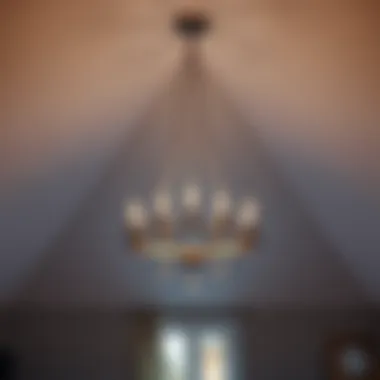
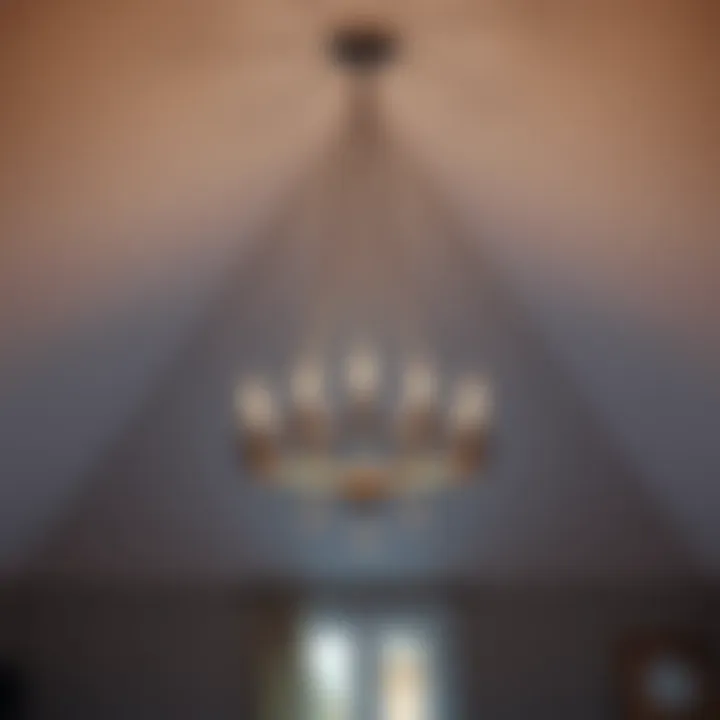
When it comes to positioning fixtures on sloped ceilings, height becomes a significant factor. If the ceiling slopes dramatically, careful consideration must be given to how low or high the fixture hangs. A fixture that is hung too low can obstruct views or become a safety hazard, whereas one hung too high may not provide adequate light or aesthetics.
A common approach is to consider the primary function of the room. For example, in a dining area, the light should ideally be about 30 inches above the table. In contrast, fixtures in living rooms might be hung higher, maintaining a balance between illumination and design.
Another critical aspect is to maintain symmetry wherever possible. When lines and angles are not mirrored or balanced, the visual appeal can diminish. Keep in mind the visual connection with walls and furniture. The height at which fixtures are installed should interact harmoniously with other architectural features to enhance the overall flow of the space.
"Lighting should not only illuminate but also transform a space into a cohesive part of the whole house design."
Selecting the Right Fixtures
Choosing the right light fixtures for sloped ceilings is a pivotal step in achieving an appealing and functional lighting design. Fixtures can make or break the ambiance of a room, and when installed on an incline, careful consideration must be given to their shape, size, and style. Not only should the fixtures complement the architectural features of the ceiling, but they also need to provide adequate illumination for the activities within the space.
When selecting light fixtures, various elements come into play, such as the height at which the fixture will be hung, the overall design language of the room, and the specific lighting requirements. The right choice enhances the aesthetic appeal while also ensuring that the space is well-lit. Here are some important points to ponder:
- Aesthetic Appeal: The visual impact of light fixtures can significantly influence the overall design of a room.
- Functionality: Fixtures must cater to the practical needs of the occupants and their daily activities.
- Versatility: Some fixtures might be more flexible in style and can adapt well to changes in decor over time.
By taking these considerations into account, homeowners and designers can fundamentally transform a sloped ceiling area into a visually striking and welcoming environment.
Types of Light Fixtures
Pendant Lights
Pendant lights are a favorite among decorators looking for style and functionality. Often hung alone or in clusters, they can serve various roles in a room.
One standout characteristic of pendant lights is their versatility; they come in countless shapes, colors, and sizes. This means they can be perfectly aligned with the theme of any space – be it modern, industrial, or rustic. They provide targeted lighting, making them an excellent choice for tasks like cooking or reading without overwhelming the entire area with light.
However, the height at which they are installed must be considered carefully, especially in sloped ceilings. If hung too low, they can obstruct views or, worse, be hazardous. Thus, tailoring the height can leverage their unique feature to emphasize design rather than detract from it.
Chandeliers
Chandeliers often evoke a sense of elegance and grandeur in a room. Typically associated with traditional and classic designs, these fixtures can also pair well with contemporary looks if designed thoughtfully.
Their key characteristic lies in their ability to diffuse light across a larger area, creating a warm and inviting atmosphere. Choosing a chandelier that fits well on a sloped ceiling can visually draw the eye upward, emphasizing the height and unique architecture of the space.
While chandeliers can serve as a strong focal point, they might be less practical in certain settings; for instance, in areas with high foot traffic, there’s a risk of the fixture becoming a nuisance or an obstruction.
Flush Mounts
Flush mounts provide a minimalist lighting solution that aligns closely to the ceiling, making them a practical choice for areas with lower ceiling heights or sloped angles. Their form factor means that they sit snugly against the ceiling, effectively maximizing space while avoiding the feeling of constriction.
A notable benefit of flush mounts is their ability to distribute light evenly throughout the room, which can be particularly effective in smaller areas or hallways where lighting needs to be broad and unobtrusive. However, one drawback is that they often lack the dramatic flair of pendant lights or chandeliers, which could leave a room feeling less dynamic if not supplemented by other design elements.
Design Compatibility with Interiors
When contemplating the selection of fixtures, it is essential to ensure their compatibility with existing interior designs. A harmonious blend between light fixtures and room decor creates a cohesive look.
A few considerations to keep in mind include:
- Color Schemes: The color of the fixture should complement existing colors in the room.
- Material Choices: Metals, wood, or glass used in fixtures can resonate with other materials present, such as furniture or flooring.
- Design Styles: A modern fixture could clash with rustic decor, so identifying a common theme can aid in making the right selection.
Measuring for Installation
Getting the measurements right is a cornerstone when it comes to hanging light fixtures, especially on sloped ceilings. It might sound simple, but proper measuring encompasses multiple facets, including the aesthetics of the fixture, the safety aspects, and the overall illumination of a room. When you think about the space where you want to hang your fixture, it’s not just about how it looks, but also how it fits into your daily life.
Finding the Right Height
Selecting the height at which to install your lighting fixture is crucial for both safety and functionality. If the fixture hangs too low, it could obstruct movement or even become a hazard in high-traffic areas.
- Eye Level: Consider the average eye-level of occupants. Ideally, fixtures should be positioned so that they are no lower than 7 feet from the floor. This offers ample space for walking without bumping into light fixtures.
- Room Proportions: The size of the room plays a vital role in determining fixture height. In a larger room, a higher hanging might create a sense of proportion. Alternatively, a small room can benefit from fixtures hung lower, drawing the eye inward and giving a cozy atmosphere.
- Fixture Design: The type of light fixture also influences height. For example, chandeliers can hang lower if they have a wide span, while pendant lights can be hung a bit higher depending on design.
Understanding Angles and Measurements
When it comes to sloped ceilings, angles become paramount. Miscalculating the angle or ignoring it can create issues ranging from unappealing aesthetics to ineffective lighting.
- Measuring the Angle: Use a protractor or a digital angle finder to calculate the slope of your ceiling accurately. This ensures that your hanging fixture will align correctly with the angle of the ceiling, creating a seamless look.
- Plumb Line Technique: Using a plumb line, which is essentially a string with a weight at the end, helps visualize how the fixture will hang. This technique ensures your fixture will appear straight and balanced, even on an uneven ceiling.
- Adjust for Fixture Lean: Understand that the angles can affect how the light is directed. The light should illuminate the space effectively. Consider adjusting the fixture's hanging point if necessary, aiming for optimal light distribution.
In summary, measuring properly for the installation of hanging light fixtures is not just a technical necessity; it’s essential for achieving both functionality and aesthetic appeal. Ignoring this vital step could lead to fixtures that are either too high or too low, failing to serve their purpose.
Installation Techniques
When tackling the challenge of hanging light fixtures on sloped ceilings, it becomes crucial to understand and apply proper installation techniques. The process is not just about aesthetics—it's about safety, functionality, and ensuring that your lighting enhances the unique contours of your space. Knowing what tools to use, the steps involved, and how to adjust to the particularities of a sloped ceiling can make all the difference in the final outcome.
Tools and Materials Required
To successfully install hanging light fixtures on sloped ceilings, you'll need the right set of tools and materials. Here’s a rundown:
- Drill and Drill Bits: Essential for creating holes to secure the mounting hardware.
- Screwdriver: Necessary for securing screws and brackets.
- Measuring Tape: To ensure accurate placement of fixtures.
- Wire Strippers: For preparing electrical wiring.
- Electrical Tape: To secure connection points.
- Mounting Bracket: Designed specifically for sloped surfaces, it helps ensure the fixture hangs correctly.
Using quality tools not only facilitates a smoother installation process but also enhances safety and durability.
Step-by-Step Installation Process
Installing a light fixture in a sloped ceiling involves careful consideration of the following steps:
Preparing the Ceiling
Before you proceed with the actual installation, prepping the ceiling is fundamentally important. This phase involves assessing the slope and measuring heights accurately to avoid any mishaps. Successful preparation ensures that the fixture hangs at an appropriate angle, providing optimal light distribution.
Key characteristic: A well-prepared ceiling means fewer adjustments later. This efficiency saves valuable time during installation, making it a wise choice for do-it-yourselfers and professionals alike.
Unique feature: By measuring the angle of your ceiling, you can establish a reliable point for your fixture, reducing complications associated with misalignment.
Mounting Hardware
Once you have the ceiling ready, fixing the mounting hardware becomes the next crucial step. The hardware used here must be specifically designated for sloped surfaces, as regular mounting kits can lead to improper installation and potential risk.
Key characteristic: Sloped ceiling mounting hardware typically features adjustable brackets that allow for customization of fixture angle and height. This gives you more control over the final appearance of the lighting fixture.
Unique feature: Adjustable hardware permits fine-tuning after the initial installation. However, remember that improper securing can result in instability. So double-check those fittings!
Hanging the Fixture
The actual act of hanging the fixture is rewarding yet requires a steady hand and attention to detail. Once the mounting is secured, carefully connect the electrical wires according to the fixture's specifications. This step often dictates how effectively the light illuminates your space.
Key characteristic: The method of hanging a fixture on a sloped ceiling differs from flat installations, making this unique technique essential to explore in-depth.
Unique feature: The right technique not only improves safety but can also enhance the room's ambiance. However, take note that if a fixture is too heavy for the mounting hardware, it can lead to future issues.
"A well-lit room is the heart of a home; it's where memories are made and moments are cherished."
By understanding these installation techniques—tools, preparations, and step-by-step guidance—homeowners and decorators can achieve effective and beautiful lighting solutions that complement sloped ceilings. For those interested in deeper dives or troubleshooting during installation, resources like Wikipedia or Reddit DIY guides can offer valuable community insights.
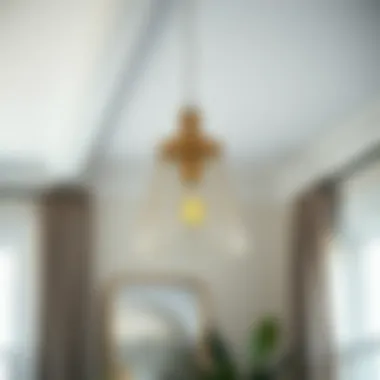
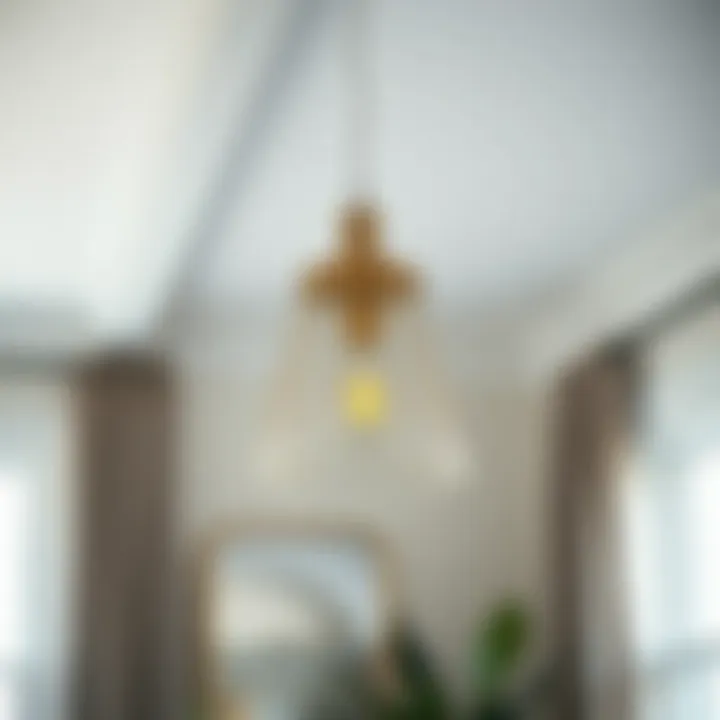
Safety Considerations
When it comes to hanging light fixtures on sloped ceilings, safety is of paramount importance. Installing fixtures on angled ceilings poses unique challenges that, if not managed correctly, could lead to accidents, electrical failures, or even fires. This section delves into the critical aspects of safety you must consider when planning your lighting installation, ensuring both functionality and peace of mind.
Electrical Safety Precautions
First and foremost, electrical safety cannot be overstated. Before embarking on any installation, it’s essential to understand the potential hazards associated with working with electricity, especially in hard-to-reach areas like sloped ceilings. Here are key electrical precautions you should adhere to:
- Turn off power: Always switch off the power at the circuit breaker before starting any work on your light fixtures. This eliminates the risk of electric shock.
- Use proper tools: Make sure you have the right tools for the job, such as insulated screwdrivers and wire strippers, to minimize any exposure to live wires.
- Check local codes: Familiarize yourself with your local electrical codes. They dictate the requirements for fixtures, wiring, and other safety measures that must be followed.
- Inspect cables and connections: Ensure that all wiring is intact with no breaks or frays, and connections are properly secured. Faulty wires are a leading cause of electrical fires.
By following these guidelines, not only will you keep yourself safe, but you'll also ensure the longevity of your installations.
Stability and Support
Another crucial element is ensuring adequate stability and support for your light fixtures. Sloped ceilings can vary significantly, and the last thing you want is a fixture that hangs precariously or is at risk of falling. Here’s how to guarantee solid support:
- Evaluate the ceiling structure: Know what you're dealing with before installation. Check if the sloped ceiling is framed with wood, drywall, or another material, as this will affect how you secure the fixture.
- Use the right mounting hardware: Various hanging mechanisms exist specifically for sloped ceilings, such as adjustable hangers. Be sure to select what matches your fixture and ceiling type.
- Load capacity: Confirm that the supporting structure can handle the weight of your fixture. Lighter fixtures may very well be hung from standard supports, but heavier ones may require reinforcement or the use of specific anchors designed to take a load.
- Installation angle: Be conscious of the angle at which your fixture will hang. This is especially vital for pendant lights and chandeliers. They should hang level and not tilt, which not only is unappealing but can also strain the wiring over time.
"Properly securing your fixtures not only enhances aesthetic appeal but also ensures the safety of everyone in the space."
In summary, taking the time to assess your electrical safety and support stability will lead to successful light fixture installations on sloped ceilings. With the right precautions and considerations, you can enjoy a beautifully lit environment without compromising safety.
Enhancing Lighting Effects
When dealing with sloped ceilings, the way lighting is utilized can markedly alter the ambiance and functionality of a space. Enhancing lighting effects not only beautifies a room but also serves practical purposes, such as improving visibility and making the most out of unique architectural features. Space with sloped ceilings, often tricky due to their angles, necessitates strategic lighting solutions that can effectively transform an area from bland to brilliant.
One significant aspect of enhancing lighting effects is to create a sense of depth and dimension. By strategically placing fixtures, you can draw the eye upward, allowing the room to seem more open and airy. Effective lighting creates visual interest, guiding the observer's gaze across the space rather than allowing their attention to flatten out. This narrative flow can make a tucked-away corner feel engaging and memorable.
Using Dimmers and Controls
Controlling how much light is available in a room can work wonders, especially with sloped ceilings. Dimmers are not merely a luxury; they offer flexibility and adaptability. With the flick of a switch, you shift the mood from energizing bright light to a soft glow that invites relaxation. This capacity helps alleviate the sometimes harsh angles of sloped ceilings, allowing different styles and atmospheres to coexist in harmony.
Benefits of using dimmers include:
- Mood Regulation: Customize the brightness to suit activities or times of day.
- Energy Efficiency: Lowering light levels can lead to notable reductions in electricity costs.
- Preservation of Fixtures: Dimming can prolong the lifespan of light bulbs by reducing wear.
- Versatile Spaces: Different settings cater to gatherings, reading nooks, or intimate dinners.
When deciding on dimmers, consider installing smart controls. These let you set schedules, adjust brightness remotely via apps, and even integrate with voice assistants, offering a modern touch to age-old lighting dilemmas.
Layering Lighting in the Room
Layering lighting is about achieving balance through a combination of different fixtures and styles. It should be a thoughtful approach that taps into ambient, task, and accent lighting simultaneously. When aiming for a well-lit environment in a room with a sloped ceiling, using multiple layers disperses the light evenly and mitigates the shadows created by angles.
Here’s how to approach layering:
- Ambient Lighting: Utilize overhead fixtures, like chandeliers or pendant lights, as a general source of illumination across the space.
- Task Lighting: Include focused lights, such as wall sconces or adjustable pendant lights, positioned correctly to help with specific duties like reading or cooking.
- Accent Lighting: Add decorative elements like spotlights aimed at artwork or plants. This uplifts the aesthetic while creating intriguing focal points.
Incorporating these various layers can create an inviting atmosphere. Strategically placing these light sources against the sloped backdrop of the ceiling can enhance architectural interest, drawing attention to unique features rather than away from them.
“The art of lighting goes beyond functionality; it’s about crafting experiences that resonate with the soul.”
Ultimately, enhancing lighting effects serves as the unsung hero of interior design on sloped ceilings. Whether with the careful use of dimmers or through crafty layering, the right lighting will breathe life into the room and allow its best features to shine.
Common Mistakes to Avoid
When it comes to hanging light fixtures on sloped ceilings, a multitude of decisions can make or break the overall aesthetic and functionality of a space. Ignoring the unique features of a sloped ceiling often leads to common pitfalls that can diminish the intended impact of the lighting. A comprehensive understanding of these common mistakes can save time, frustration, and potentially money. Not only do these oversights affect visual appeal, they can also hinder the effectiveness of the lighting in a room, reducing its overall utility.
Underestimating Space Requirements
One glaring faux pas is underestimating the space requirements when selecting light fixtures. Sloped ceilings vary in height and angle, which can drastically influence the amount of space needed for proper fixture installation. Closely analyzing the dimensions and the slope of the ceiling is essential. Fixtures that seem perfectly sized for a flat ceiling may not translate well when installed on an angle.
If homeowners or designers fail to account for this, they might end up with fixtures that hang lower than desirable, making a space feel cramped. Similarly, inadequate clearance can create navigation issues, especially in areas where people frequently walk.
"You really want to consider how low the fixture hangs. Nobody wants to bump their head every time they take a stroll across the room."
To avoid this mistake, measure the available vertical space, and determine how far down the fixture will extend from the ceiling. Here’s a quick checklist to help:
- Measure the Height: From the floor to the highest point of the ceiling.
- Consider Fixture Height: Add the height of the fixture to your measurements.
- Create Adequate Clearance: Ensure that it is at least 7 feet above the floor for safe clearance.
Taking these steps ensures that the light fixture will not only match aesthetically but also serve its functional purpose without obstruction.
Choosing Inappropriate Fixture Types
Another classic error in lighting choice is selecting inappropriate fixture types for sloped ceilings. Pendant lights, chandeliers, and flush mounts all have different profiles that can dramatically alter how a room looks and feels. For instance, Chandeliers with long chains can appear awkwardly positioned in a slope, while pendants are often more versatile in these situations.
In contrast, flush mount fixtures are sometimes overlooked, but they can suit low-slope ceilings well and still provide adequate light without the risk of hanging too low. Additionally, modern technology now offers adjustable fixtures that can help tailor the light's angle, providing flexibility that may solve some spacing issues altogether.
When choosing fixtures, consider:
- Style: Does it align with the overarching design theme of the space?
- Hanging Mechanism: Is it adjustable or fixed? Can it accommodate the slop of the ceiling?
- Size and Scale: Is the fixture proportionate to the room?
Choosing the right fixtures is essential not just for aesthetics but also for maximizing light distribution, which can affect the room's ambiance. A well-chosen light fixture can accentuate the unique features of a sloped ceiling while drawing attention to other design elements within the space.
In summary, avoiding underestimating space requirements and recognizing appropriate fixture types are critical to achieving successful installations that enhance both functionality and style. By steering clear of these common missteps, one sets the stage for an inviting and well-lit environment.
Maintaining Your Fixtures
Maintaining light fixtures, especially those hanging from sloped ceilings, is not just about aesthetics; it is about ensuring functionality and safety. These fixtures are often crucial for illuminating living or working spaces. If not maintained, they can become less efficient at providing light, which ultimately detracts from the ambiance of a room. Regular maintenance can extend the life of the fixtures, shielding them from wear and tear that development over time due to dust, grime, and the natural degradation of materials. A consistent care regimen ensures that your fixtures not only look their best but also remain safe and effective in operation.
Cleaning and Care Tips
Keeping your fixtures clean is a requirement that shouldn't be overlooked. Dust and moisture can collect in both plain bulbs and intricate designs. Here are some practical cleaning methods:
- Regular Dusting: At least once a month, take a feather duster or a microfibre cloth to gently clear away any dust residing on the surfaces of your fixtures. For sloped ceilings, this might take some reaching. A step stool or small ladder can be quite handy.
- Deep Cleaning: Use a damp cloth with mild soap for a thorough clean every few months, depending on the environment. This is especially important in areas with high humidity, such as kitchens or bathrooms, where grease and moisture can build up.
- Check Bulbs: Make it a habit to review the condition of the bulbs. Burnt-out bulbs not only give poor light but can also cause overheating in fixtures still trying to send current to them. Let’s keep those bulbs bright!
Regular Inspection for Safety
Inspecting your light fixtures for safety is paramount. Over time, connections may loosen, and structures may weaken, especially when fixtures are hung from sloped ceilings. Here's what to look for during an inspection:
- Wiring and Connections: Every few months, check if the wiring is intact and well-connected. A frayed wire can be a major fire hazard.
- Tightness of Mounting: Periodically ensure that the mounting hardware is holding strong. A fixture that is loose can swing and lead to damage or accidents.
- Overall Condition: Examine for any corrosion or rust on metal fixtures or material degradation in non-metallic fixtures. Any signs of wear or age are calls for concern, requiring immediate attention.
"Regular maintenance of light fixtures can yield long-term benefits, saving on energy costs and ensuring safety at home."
These practices, though straightforward, often get sidelined in our busy lives. Making them a part of your home care routine can result in a well-lit, safe environment that looks great and functions optimally. Remember, the trust between you and your light fixtures is built on care and attention, and that trust pays dividends down the line.
Innovative Trends in Lighting Design
Innovative lighting design is becoming a pivotal aspect of modern interiors, especially when dealing with the unique challenges of sloped ceilings. In today’s world, homeowners and designers are focusing not only on the functionality of light but also on how it can transform a space visually. Understanding these innovative trends means you can make informed choices that enhance not just illumination, but the entire ambiance of your home.
Smart Lighting Options
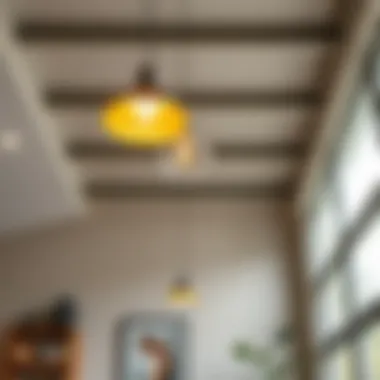
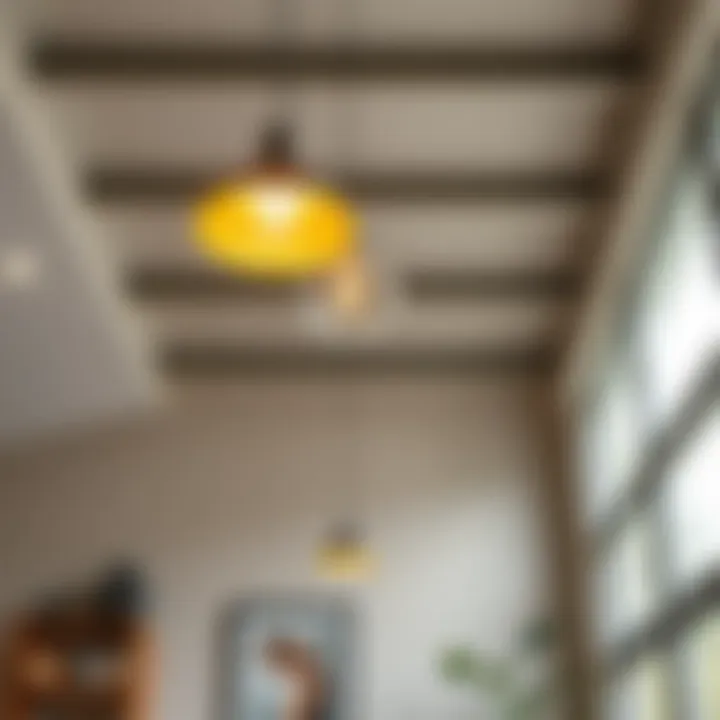
Smart lighting has revolutionized the way we interact with our homes, allowing for a flexibility that was once unimaginable. Imagine being able to control your light fixtures from the palm of your hand, adjusting brightness and color temperature to suit your mood or activity—all with just a tap on an app or a voice command.
When applying smart lighting to sloped ceilings, consider fixtures that integrate seamlessly with smart home systems like Philips Hue or Lutron Caseta. They offer solutions that can be adjusted as you move about the room, which is particularly beneficial in a space where light levels might need to vary. For instance, a dimmer switch could help lower the brightness for a cozy movie night, while brightening up for an engaging reading session. This adaptability not only adds convenience but also contributes to energy efficiency, a growing concern for many homeowners today.
"The future of lighting isn’t just bright; it’s smart. Constantly adaptable, smart lighting brings both practicality and sophistication to sloped ceilings, enhancing aesthetic appeal in the process."
Integrating Smart Fixtures
- Choose fixtures that are compatible with existing smart home technology.
- Consider voice-controlled options for ease of use.
- Ensure automation capabilities for scheduled lighting activates, aiding in energy conservation.
Sustainable and Eco-friendly Choices
As we become more conscious of our environmental impact, sustainable lighting options have gained traction. When dealing with sloped ceilings, preserving both aesthetic elements and energy efficiency becomes paramount. Today, many manufacturers offer eco-friendly fixtures made from sustainable materials alongside LED technology, which consumes significantly less energy than traditional incandescent bulbs.
Choosing LED fixtures not only reduces electricity usage but also extends the product lifespan, meaning replacements are less frequent. Moreover, fixtures crafted from recycled or responsibly sourced materials can make a striking statement in your home, merging ethics with style. Consider fixtures that utilize natural fibers or finishes that reflect a commitment to sustainability, like those from West Elm or Crate & Barrel.
Benefits of Sustainable Lighting
- Lower energy costs through reduced consumption.
- Longer-lasting fixtures, which contribute to less waste.
- Enhanced home value with modern, eco-conscious designs.
By exploring these innovative trends in lighting design, from embracing smart technology to opting for sustainable choices, you elevate not just the functionality of your sloped ceiling spaces but also your overall lifestyle. Every choice you make can trickle down to create a living environment that is both aesthetically pleasing and in tune with the needs of our planet. In the realm of lighting, these advancements aren't merely trends but essential steps in crafting beautiful and responsible spaces.
Real-world Applications
When it comes to sloped ceilings, the practical applications of hanging light fixtures extend beyond mere aesthetics. Choosing the right lighting in these spaces can create transformative effects that enhance the functionality and ambience of both residential and commercial environments. Understanding the real-world applications of lighting in sloped ceilings helps homeowners, interior decorators, designers, furniture retailers, and DIY enthusiasts make informed choices that align with their design goals and usage needs.
Residential Spaces
In residential settings, sloped ceilings often add a distinct charm and personality to a home. However, they also present unique challenges when it comes to lighting. For instance, in a cozy attic bedroom or a spacious living room with a vaulted ceiling, the right hanging light fixture can serve multiple purposes:
- Functionality: A well-lit space is essential for everyday activities. In a living room, pendant lights can illuminate gathering areas, while chandeliers can serve as focal points that brighten the whole room.
- Zone Definition: Pendant fixtures can be used to visually define areas within open-plan spaces. For example, placing a pendant over a dining table can delineate the dining zone, making it more inviting and usable.
- Highlighting Features: Sloped ceilings often come with unique architectural features. Installing fixtures that can highlight these elements not only showcases the design but also enhances the overall flow of light in the room.
For instance, a striking pendant light can underscore a beautiful wooden beam, drawing the eye and adding depth to the space. By carefully choosing the height and type of fixture, homeowners can avoid creating dark corners, which are common in spaces with steep angles.
"A well-lit sloped ceiling can be the crown jewel of a room, accentuating its architectural beauty while providing necessary illumination."
Commercial Environments
In commercial environments, the role of lighting on sloped ceilings varies greatly but remains just as crucial. Businesses can leverage lighting design to enhance their brand image and create a welcoming atmosphere. Considerations here might include:
- Branding: Custom fixtures that align with a brand’s aesthetic can create a cohesive look that attracts customers. For example, a trendy café might use unique, artistic pendant lights that signal creativity and comfort to patrons.
- Efficiency: In workspaces, thoughtful lighting solutions can improve productivity. Well-placed fixtures can help minimize glare on screens and reduce eye strain, creating an environment conducive to focus and creativity.
- Customer Experience: Retail spaces, such as boutiques with sloped ceilings, can utilize lighting to create an inviting ambiance. Bright lights can highlight products, while softer, warmer fixtures can enhance customers' shopping journeys.
Design strategies such as the use of multiple light sources—like combining ambient and task lighting—can effectively enhance usability without sacrificing style. In this way, businesses can create an environment where space feels open and accessible, regardless of the ceiling’s incline.
Overall, the application of hanging light fixtures on sloped ceilings in both residential and commercial settings emphasizes the need for a thoughtful approach to not only illuminating spaces but also creating an environment that resonates with users.
Case Studies in Successful Installations
Understanding how to effectively install hanging light fixtures on sloped ceilings draws benefit from real-world applications. These case studies are not just anecdotes; they demonstrate practical solutions, enhancing readers’ confidence in their potential projects. By examining distinctive residential projects and innovative commercial examples, we glean insights that translate into informed decisions and improved outcomes in lighting design. Whether for aesthetic value or functional effectiveness, the lessons learned from these installations showcase the transformative power of thoughtfully placed lighting.
Distinctive Residential Projects
Homeowners often face unique challenges when it comes to sloped ceilings, but inspiration can be found in various residential projects that have successfully tackled these obstacles. For instance, a modern mountain retreat in Colorado exemplifies the use of pendant lights that hang gracefully from vaulted ceilings. These fixtures were strategically selected not just for illumination, but to echo the angular lines of the architecture, reinforcing the home’s aesthetic appeal.
In another example, a contemporary urban loft utilized flush mounts to keep a clean line in both the living space and the kitchen area, ensuring that space feels cohesive. Custom wiring allowed the fixtures to align perfectly with the peak of the ceiling, enhancing the room’s sleek design while providing necessary light.
Moreover, using dimmable LED fixtures allowed occupants to adjust brightness based on the time of day and activity, creating dynamic atmospheres. These projects showcase how thoughtful selection and placement can transform a space while also addressing the distinctive challenges posed by sloped ceilings.
Innovative Commercial Examples
On a larger scale, commercial installations offer additional inspiration for lighting on sloped ceilings. A notable case is an art gallery that installed a series of recessed lights along sloped walls to illuminate various exhibits. This not only provided adjustable lighting for art displays but also enhanced the gallery's modern aesthetics.
Additionally, a high-end retail store utilized hanging fixtures suspended over a sloped ceiling to create a visually striking focal point. The lighting design incorporated a mix of large chandeliers and smaller spotlights, tailored to enhance product displays while ensuring general lighting maintained a comfortable shopping environment.
These commercial examples demonstrate the importance of light in not just functionality but creating an overall atmosphere that encourages engagement with the space. Clarity in design can transform an average area into an inviting atmosphere that speaks to both the brand and the consumer.
"Lighting can energize a space, turning even the most mundane corners into magical spots."
Expert Insights and Recommendations
When it comes to hanging light fixtures on sloped ceilings, navigating through the installation and design process can feel like trying to thread a needle in the dark. Expert insights play a crucial role in shining a light on this complex topic. They provide not only guidance but also reassurance to homeowners, interior decorators, and designers venturing into this often-tricky domain.
Benefits of Relying on Expert Opinions
Engaging with industry professionals can bring various advantages:
- Avoiding Pitfalls: Experts can pinpoint common mistakes, like underestimating fixture weight or ceiling angle, which can lead to improper installations.
- Understanding Aesthetics: They can recommend fixture styles that not only match the slope of the ceiling but also complement the room's decor.
- Practical Advice: Hands-on tips from professionals about tools, materials, and techniques simplify the entire process for DIY enthusiasts.
Taking advice from professionals enhances the likelihood of achieving both functional and aesthetically pleasing results. Every sloped ceiling is unique, and thus, recommendations rooted in real-world experience often prove invaluable.
Industry Professional Advice
When selecting and installing lighting fixtures, professionals emphasize a few fundamental principles:
- Choose Adjustable Fixtures: Consider pendants or chandeliers that can be adjusted or angled. This flexibility allows for better illumination aimed strategically toward areas needing light.
- Pay Attention to Scale: It’s important that the size of the fixture aligns with the height and slope of the ceiling. A massive chandelier can overwhelm a low-slope ceiling, whereas small fixtures might get lost in a towering space.
- Mind the Wiring: Experts often highlight that the wiring must be adapted for the ceiling’s angle. Using appropriate mounting brackets and ensuring secure connections is primary to safety and performance.
Understanding these elements ensures that a project's success leans less on guesswork and more on informed decision-making.
Frequently Asked Questions
1. How do I choose the right type of light fixture for my sloped ceiling?
Selecting a fixture should depend on the ceiling's angle and height, as well as the overall design of the space. For steep slopes, adjustable fixtures may be best, while shallower angles might permit broader options.
2. Are there particular brands that specialize in sloped ceiling fixtures?
Yes, brands like Kichler and Westinghouse offer a variety of designs tailored for sloped ceilings, allowing for both functional lighting and creative expression.
3. What if I’m uncertain about my ceiling's angle?
A simple protractor or angle finder can measure the incline accurately. Many home improvement stores sell affordable devices for this purpose. Alternatively, professionals can assist in making these measurements if unsure.
4. Should I hire a professional for the installation?
While some fixtures can be installed easily by a homeowner with the right tools, hiring professionals is advisable when dealing with complex installations or electrical work to ensure safety and compliance with local codes.
5. How can I incorporate smart lighting in a sloped ceiling installation?
Smart fixtures and bulbs can be added easily at the time of installation or retrofitted later. Look for options compatible with smart home systems to enable adjustments through apps or voice commands.
With these answers, readers can navigate their projects with confidence and clarity.
Finale and Final Thoughts
As we draw the curtain on this comprehensive look at hanging light fixtures on sloped ceilings, it's imperative to underline the significance of the insights gathered here. Navigating the world of lighting with such architectural features can seem daunting at first glance, but the journey through these considerations unravels essential techniques that can transform any space into a realm of warmth and functionality.
Understanding the dynamics of sloped ceilings equips homeowners and decorators alike with knowledge that goes beyond mere illumination. It's about marrying aesthetics with utility. Properly installed light fixtures not only highlight the unique shapes and lines of a room but also contribute significantly to safety and comfort. The blend of style and practicality is crucial here, making it vital to choose the right fixtures while keeping in mind the overall ambiance you wish to achieve.
Summarizing Key Insights
- Know Your Ceiling Type: Understanding if your ceiling is cathedral, vaulted, or a low-slope is paramount in selecting the right fixtures.
- Height and Angle Matter: Accurate measurements ensure fixtures hang at an ideal height, improving both safety and aesthetics.
- Consider Lighting Layers: Mixing ambient, task, and accent lighting can add depth and dimension, making the space more inviting.
- Fixture Selection is Key: Depend on styles that harmonize with room aesthetics while also addressing functionality.
- Safety First: Always prioritize electrical safety and stability during installation to avoid mishaps down the line.
Encouragement towards Thoughtful Decisions
In embarking upon the adventure of selecting hanging light fixtures for sloped ceilings, approach every decision with intention. Ask yourself what ambiance you want to create and how the lighting impacts daily activities. Don’t hesitate to explore different combinations and placements—experimentation can uncover delightful surprises that harmonize your space beautifully.
Moreover, consider the long-term effects of your choices. Investing in durable, stylish fixtures can lead to lower replacement costs down the road. Always keep an eye out for innovative and sustainable options that not only look good but are environmentally friendly too.
With these reflections, the potential in your sloped ceiling spaces may just be bounded only by your imagination. Keep the principles outlined in this guide close, and let your creativity shine.



